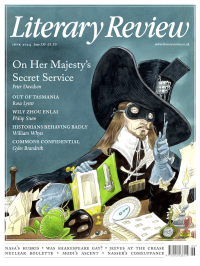Jonathan Boff
Fighting Talk
Why War?
By Richard Overy
Pelican Books 400pp £22
On 15 December 1969, cities all over the world woke up to billboards proclaiming, ‘War is Over!’ Paid for by John Lennon and Yoko Ono, the advertisement was not, of course, meant as a statement of fact. It was an appeal to stop the fighting and dying in Biafra and Vietnam. As ever, you had to read the small print beneath the banner headline: ‘If you want it.’ Lennon and Ono were using the techniques of selling soap to promote peace over the rival brand of war. Their logic was simple: if each one of us rejected war, we could together put an end to it. How could anyone sane want anything other than the end of war?
For Vietnam and Biafra then, read Ukraine and Gaza now. The question remains as tragically relevant today as it was in 1969, or in 1935, when eleven million British voters signed the Peace Ballot, or at the end of the 18th century, when Jeremy Bentham and Immanuel Kant made their proposals for ‘perpetual peace’. It is the question that Richard Overy asks in Why War?. The title comes from a famous correspondence between Albert Einstein and Sigmund Freud that took place in 1932. Overy, a distinguished historian of the Second World War, explores how the discourse on war has developed since then. This is a work of history, therefore, but one that seeks to uncover the general principles that drive the human resort
to war rather than the origins of particular conflicts.
Overy has set himself a formidable task, and one he only makes harder for himself by adopting a very broad definition of warfare as ‘collective, purposive, lethal, intergroup violence’. He must explain not only why collectives such as clans, tribes and states go to war, but also what motivates individuals

Sign Up to our newsletter
Receive free articles, highlights from the archive, news, details of prizes, and much more.@Lit_Review
Follow Literary Review on Twitter
Twitter Feed
It wasn’t until 1825 that Pepys’s diary became available for the first time. How it was eventually decrypted and published is a story of subterfuge and duplicity.
Kate Loveman tells the tale.
Kate Loveman - Publishing Pepys
Kate Loveman: Publishing Pepys
literaryreview.co.uk
Arthur Christopher Benson was a pillar of the Edwardian establishment. He was supremely well connected. As his newly published diaries reveal, he was also riotously indiscreet.
Piers Brendon compares Benson’s journals to others from the 20th century.
Piers Brendon - Land of Dopes & Tories
Piers Brendon: Land of Dopes & Tories - The Benson Diaries: Selections from the Diary of Arthur Christopher Benson by Eamon Duffy & Ronald Hyam (edd)
literaryreview.co.uk
Of the siblings Gwen and Augustus John, it is Augustus who has commanded most attention from collectors and connoisseurs.
Was he really the finer artist, asks Tanya Harrod, or is it time Gwen emerged from her brother’s shadow?
Tanya Harrod - Cut from the Same Canvas
Tanya Harrod: Cut from the Same Canvas - Artists, Siblings, Visionaries: The Lives and Loves of Gwen and Augustus John by Judith Mackrell
literaryreview.co.uk